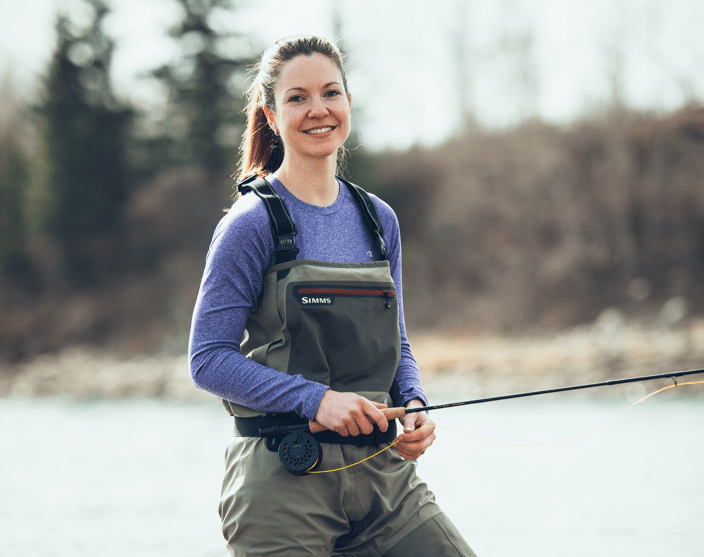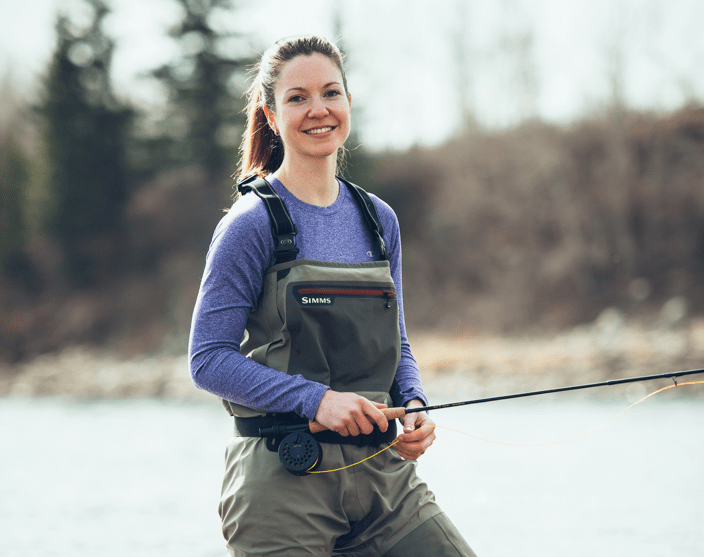
Published on January 20, 2019
Spirit of NAIT Alumni Award recipient at the intersection of conservation and development
Jessica Reilly’s husband, Blair, may wish sometimes that his spouse didn’t embrace quite so closely the American essayist and poet’s approach to travel. The NAIT graduate seldom chooses the “easy” way into the backcountry, preferring to wander cutlines and often chooses bushwhacking over travelling the more-established trails.
It began early in her life—she thinks at age six—as she accompanied her father and her uncle on her mother’s side of the family on fishing excursions to remote lakes and rivers in northern Alberta and British Columbia. “It was such a fantastic experience. Now I love being next to a river. I can’t imagine doing anything else.”
“Do not go where the path may lead, go instead where there is no path and leave a trail.”
- Ralph Waldo Emerson
It was natural, therefore, following stints in industry and at other post-secondary institutions, the self-described “angler at heart” would choose a career focused on the conservation of fish stocks. At age 12, she already knew what she wanted to do with her life.
Today, Reilly, (Biological Sciences Technology – Renewable Resources '05) is a fisheries biologist with the Government of Alberta, responsible for the design and delivery of regional fisheries management programs. She is currently the provincial species lead for bull trout, developing a recovery plan for the species.
While working in the operations division of Alberta Environment and Parks, she developed and pioneered a provincial fish sustainability index for bull trout, using tools including geographic information systems, climate models, advanced statistics and government databases.
Following the completion of her undergraduate science degree at the University of Victoria in 2009, she went to work for Golder Associates Ltd., an international company with strong environmental consulting services, where she coordinated small- and large-scale projects related to fish and fish habitat assessments and environmental impact assessments. “I really honed my field skills, project coordination and project management skills, but I was losing touch with science and I really wanted to get back to my science-based roots, and focus on conservation.”
So she enrolled in a Master’s program at the University of Alberta; she estimates that work took her to perhaps 40 different rivers in the province.
“Jess produced one of the top theses that have come from my lab,” explains co-supervisor and professor of biological sciences David Coltman. “Her work is clearly very important to Arctic grayling conservation and management in Alberta. Furthermore she was totally dedicated to ensuring that her results were shared not just with the scientific and academic communities, but with policymakers and stakeholders.”
Co-supervisor Cynthia Paszkowski says Reilly “certainly embraced research in conservation genetics even though this area was quite removed from her earlier interests and training.”
Those work and educational experiences have now placed Reilly at the intersection of conservation and development issues. It’s not always a comfortable place.
“Not only do I need to be an expert in fisheries sciences and management, I also need to be pretty aware of other sciences. I have to be able to consult with people, stand in front of big crowds and mediate difficult conversations. (She credits her time as a parks naturalist for honing those skills, but she’s thankful she no longer has to dress up as a yellow warbler.) I have to have an understanding of policy and law—and certainly politics—and really understand how the industrial sectors are working on the ground, in forestry, oil and gas and mining.
“Some of my colleagues call these ‘wicked problems’. We are facing really complicated economic, social and conservation problems in Alberta, and we don’t do a very good job talking about trade-offs.” Although she hastens to add, that she has to careful when she and her husband, an operations performance manager with the Alberta Energy Regulator, are engaged in impassioned discussion at parties. The risk of boring others is high, she says.
“There’s the general sense,” she continues, “that we should be able to do anything, anyhow, anywhere and still have a healthy native fish, but it’s clear that’s not working. We have a growing list of species at risk in Alberta and what we really need to do is have a clear and open dialogue about the consequences of our actions grounded in good science.” Closing the commercial whitefish fishery recently was tough, but it created breathing room for other species, such as walleye and northern pike.
The 30-year-old biologist is not pessimistic, however.
“We’ve had some real wins in Alberta in the past. In the 1970s and ‘80s many of our walleye populations were collapsing. We then put in more stringent regulations and harvest licenses and now we have one of the best [sport] fisheries in Canada,” she points out, adding that her role is to inform the conversations and provide that science-based advice to people making decisions. “I’m an advocate for fisheries, but of course there are so many other values out there. I just hope fisheries have a voice at the table.”
Reilly is increasingly committed to bringing her voice back to NAIT. Today, she is heavily involved with the institute, instructing a number of courses, chairing the program’s advisory committee from 2009 to 2012 and working on various research projects that include students. She hires NAIT grads—many are now women—and in 2015 she became a donor to support student awards.
She and retired fisheries biologist Jim O’Neil, one of her earlier-career mentors who is now closely involved with Trout Unlimited work, recently worked with eight NAIT students enrolled in a project management course to summarize and analyze data related to a grayling recovery program on the Pembina River. “Super fun,” Reilly says emphatically, to listen to presentations, teach students mapping and share time with passionate people.
The joy and importance of mentoring others was certainly modelled by another one of her favourite people, Associate Chair Biological Sciences Technology Dave Critchley, who was an influential instructor at NAIT when she studied here. Now, he’s a colleague and friend she works with closely. He’s completely dedicated to his students and conservation research projects, she says about the wetland biologist.
“When I was doing my master’s, I was having some analysis problems and I called him up. He showed up at my house the next morning with a stack of textbooks—and he would do that for any of his students.”
Critchley, the recipient of a number of the institute’s instructional excellence awards, says department staff members are proud to be “part of her school.” She never turns away from a learning or teaching opportunity and always does this with a smile and enthusiasm that astounds others.
And Critchley has always been impressed with the way she works a room: “She may be fresh off the stream conducting fisheries management work and stroll directly into a board room to take control of a stakeholder meeting. Most people leave with a better understanding of the real issues and likely a high level of support for the initiative she is proposing.”
Her peers, about 30 or so scattered around the province, each with specialized skills, admire her work. She’s received numerous scholarships and awards recognizing her contributions to the fisheries. This year's recipient of the Spirit of NAIT Alumni Award speaks about her work at community outreach programs and her work has been published in a number of journals.
And if this all sounds like all work and no play, she admits she has to work at keeping a balance. So what’s that actually look like? Well last year, for example, she and two of her friends, Laura McPherson and Kristy Wakeling—of course, they’re biologists—chartered a flight to a remote lake in the NWT to—you guessed it—fish for those legendary 20-inch grayling. The days were long, the river was teeming with fish, and the place was magical. But at four in the morning one night, Reilly awoke to see Wakeling’s head being tossed back and forth. A black bear had landed on the tent. A little noise, a gunshot and the cub was treed.
They’re already talking about the next big adventure, and Reilly can be expected to adhere to another one of Emerson’s dictates: “Live in the sunshine, swim the sea, drink the wild air.” She just happens to be blessed enough to be able to do that at work and at play.
Share this page:

Jessica Reilly
Fisheries Biologist, Government of Alberta
(Biological Sciences Technology – Renewable Resources '05)
Share on Facebook